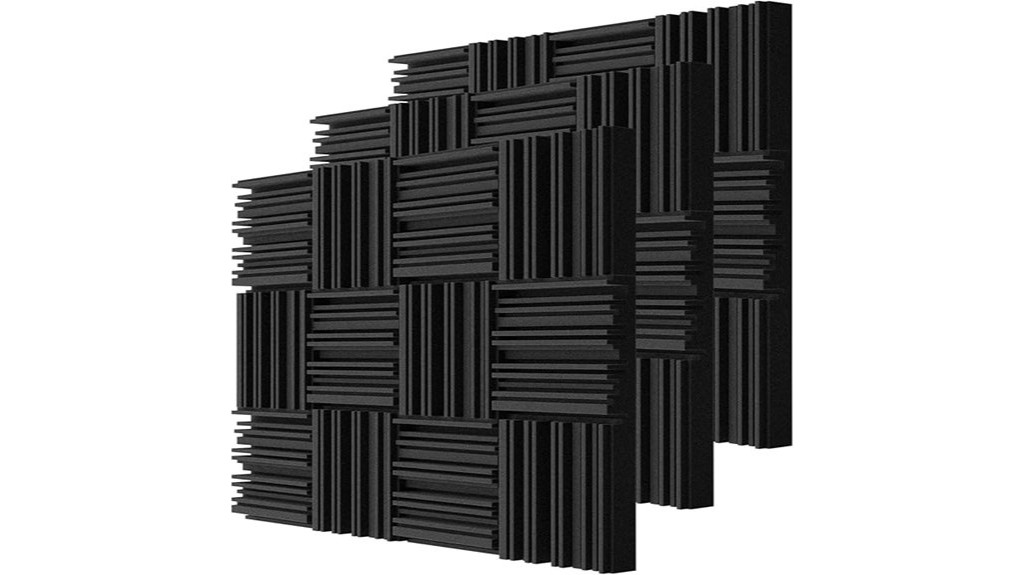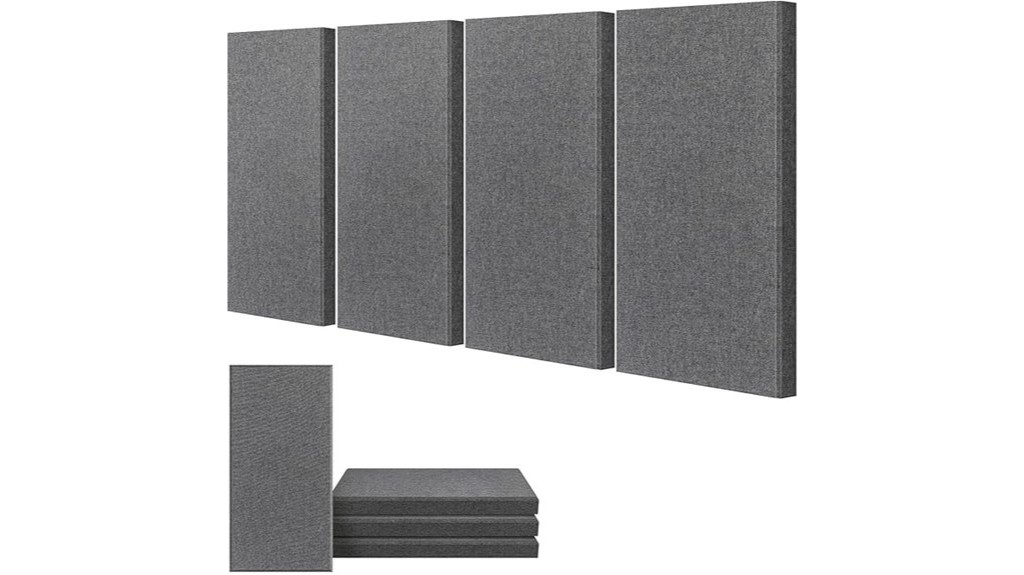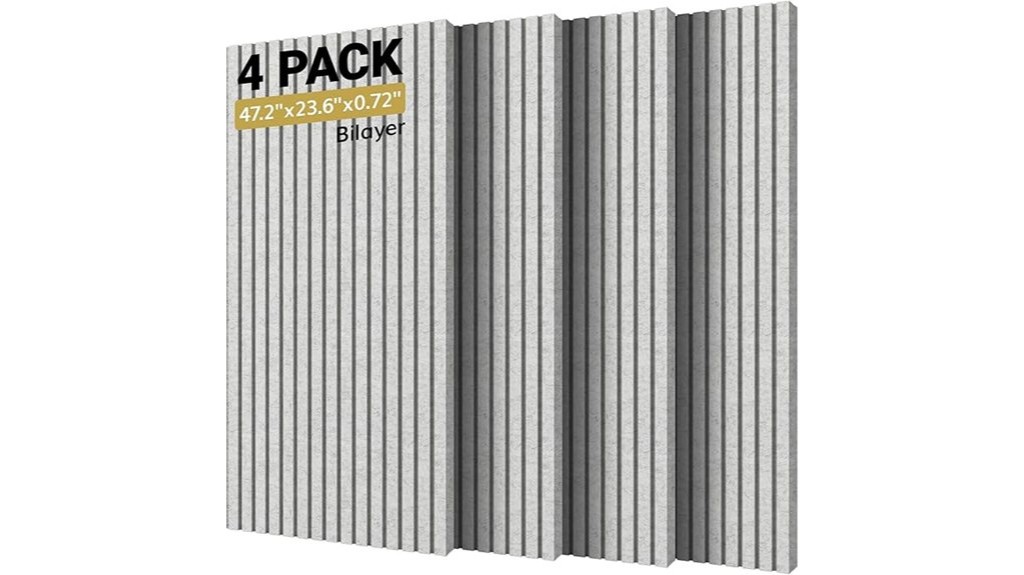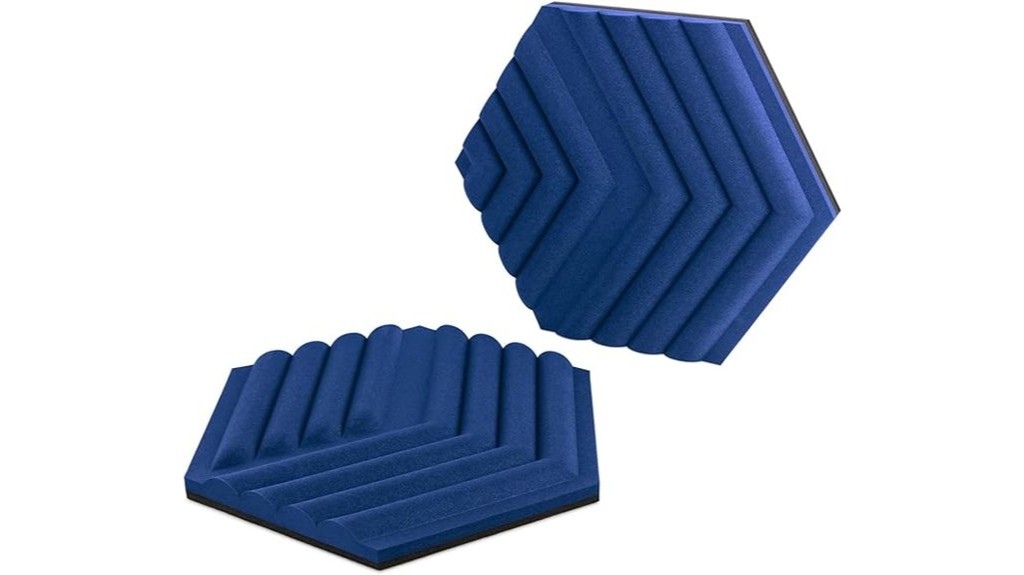This post may contain affiliate links, and we may receive commission if you purchase any of the products listed below.
Imagine your home studio as a blank canvas, waiting for the right brushstrokes of acoustic treatment to transform the soundscape. Selecting the best types of sound treatment is essential to achieving clarity and precision in your recordings. Consider options like TroyStudio’s high-density foam panels and UMIACOUSTICS’ fiberglass core panels, which offer impressive noise reduction coefficients. Each choice impacts your audio environment uniquely, promising enhanced acoustics and aesthetic appeal.
Assessing Your Space for Home Studio Sound Treatment
To effectively assess your space for home studio sound treatment, start by measuring your room dimensions to understand the scope of acoustic challenges. Identify noise sources and evaluate areas prone to sound reflections, like corners and parallel walls, which will guide your treatment strategy. Determine the ideal equipment placement based on these findings to enhance sound clarity and minimize unwanted reverberation.
Identify Room Dimensions
Understanding your room’s dimensions is the first critical step in soundproofing your home studio. Begin by measuring the length, width, and height to calculate the room volume. This measurement directly informs the type and quantity of acoustic materials you’ll need. Smaller rooms often face issues with low-frequency build-up, necessitating precise treatment like bass traps in corners. Next, identify the room shape. Square or rectangular spaces can produce standing waves, creating uneven sound distribution. Consider using the “golden ratio” (1:1.618) for ideal proportions, minimizing resonances naturally. Properly analyzing these dimensions guarantees you address acoustic challenges effectively, laying the groundwork for a balanced sound environment. Mark potential reflection points to target wall treatments, optimizing sound clarity and depth.
Evaluate Acoustic Challenges
After calculating your room’s dimensions, the next step involves a thorough evaluation of acoustic challenges within your home studio. Begin by identifying reflection points, essential for pinpointing areas where sound waves bounce off surfaces. Use a mirror to find these points; where you see your speakers from your listening position, needs acoustic paneling. This reduces unwanted reflections, enhancing sound clarity. Analyze your room for excessive reverberation, particularly in parallel walls and corners, as these often accumulate sound waves. Low frequencies can build up in these areas, causing imbalance. Address this by placing bass traps in corners. Utilize tools like Room EQ Wizard to monitor frequency responses, which guide your treatment decisions for a balanced acoustic environment.
Locate Noise Sources
While setting up your home studio, identifying noise sources is crucial to achieving ideal sound quality. Start by measuring noise levels using a decibel meter or sound level app to pinpoint areas with significant noise interference. This aids in implementing effective noise isolation. Examine your room’s layout, focusing on hard surfaces like walls and floors that cause sound reflections, degrading acoustics. Also, evaluate how furniture might exacerbate or reduce these reflections. Pay attention to windows and doors, which often allow noise leakage. Consider sealing gaps or using soundproofing materials. Conduct a listening test by recording an audio sample to detect unwanted background noise, helping you identify areas needing targeted treatment for optimal studio performance.
Determine Equipment Placement
When setting up your home studio, precisely determining equipment placement is essential for achieving ideal sound quality. Start with speaker positioning: arrange your speakers to form an equilateral triangle with your listening position. This guarantees maximum sound clarity by maintaining equal distances from each speaker to your ears. Avoid placing speakers near walls to minimize reflections, which can distort audio. Use a mirror to identify reflection points on walls; treat these areas with acoustic panels to control early reflections that affect sound clarity. Consider vertical alignment—your listening position should account for ceiling height. Implement ceiling clouds for better acoustics. This meticulous approach will enhance your studio’s sound clarity, providing a professional audio environment for recording and mixing.
Best Types of Home Studio Sound Treatment
When selecting sound treatment options for your home studio, consider the effectiveness of products like TroyStudio Thick Acoustic Foam Panels and UMIACOUSTICS 4 PCS Acoustic Panels for absorbing mid to high frequencies. The TONOR 4-Pack Bilayer Acoustic Panels and Sonic Acoustics Self-Adhesive 12 Pack Hexagon Acoustic Panels provide versatile solutions for managing sound reflection and absorption. For a modular approach, the Elgato Wave Panels Starter Set offers customizable configurations to suit your specific acoustic needs.
TroyStudio Thick Acoustic Foam Panels

TroyStudio Thick Acoustic Foam Panels are an excellent option for anyone seeking effective sound treatment in their home studio. These panels, sized at 12 X 12 X 2 inches and sold in packs of 36, offer thorough 36-square-foot coverage. Made from high-density polyurethane, they feature a periodic groove structure that enhances both functionality and aesthetics. With a Noise Reduction Coefficient of 0.8, they excel at minimizing reverb and echo. Installation is straightforward using tape or adhesive, and they’re flame retardant, complying with California Technical Bulletin 117-2013. Users appreciate their noise-dampening capabilities but note occasional expansion and thickness inconsistencies.
Best For: Home studio enthusiasts, podcasters, YouTubers, and streamers seeking superior audio quality and effective sound treatment.
Pros:
- High noise reduction with a Noise Reduction Coefficient of 0.8.
- Easy installation with minimal wall damage.
- Flame retardant and compliant with safety standards.
Cons:
- Some users experience issues with panel expansion and thickness consistency.
- Occasional aesthetic appearance concerns post-installation.
- Reports of odor from the panels.
UMIACOUSTICS 4 PCS Acoustic Panels

The UMIACOUSTICS 4 PCS Acoustic Panels are an ideal choice for anyone seeking to enhance sound clarity in a home studio or similar environment. With dimensions of 2” thick and 23.6 x 11.8 inches, these panels feature high-density polyester fabric and an E0-rated white fiberglass core. Their NRC rating of 0.95 signifies excellent absorption of echoes and reverberation, outperforming thinner alternatives. Despite some adhesive issues, versatile mounting options, including customer service-provided brackets, guarantee stability. Users rate them 4.3 out of 5 stars, praising significant acoustic improvements. For best results, consider additional adhesive for secure installation.
Best For: Those seeking to enhance sound clarity and reduce echoes in home studios or similar environments.
Pros:
- High NRC rating of 0.95 for superior sound absorption.
- Made from high-density polyester and E0-rated fiberglass, ensuring quality and durability.
- Versatile mounting options, including self-adhesive and customer service-provided brackets.
Cons:
- Some users experience issues with adhesive performance, leading to potential instability.
- May require additional adhesive for secure installation.
- Mixed effectiveness of self-adhesive, suggesting alternative mounting methods may be necessary.
TONOR 4-Pack Bilayer Acoustic Panels

For those seeking superior sound absorption in their home studio, the TONOR 4-Pack Bilayer Acoustic Panels stand out as an effective solution. Each panel, measuring 47.2″ x 23.6″ x 0.72″, features a dual-layer design of high-density polyester fiber, optimizing sound absorption and noise blocking. Installation is straightforward with their self-adhesive backing, allowing you to peel and stick onto various smooth surfaces effortlessly. These panels not only enhance acoustical performance but also maintain aesthetic appeal with a classic stripe pattern. Users report an 80-90% noise reduction, thanks to the panels’ dense construction, ensuring lasting quality and privacy in your studio.
Best For: Individuals seeking to enhance sound quality and reduce noise in home studios or other rooms with easy installation and aesthetic appeal.
Pros:
- Dual-layer design for superior sound absorption and noise reduction
- Easy installation with self-adhesive backing, minimizing wall damage
- Maintains aesthetic appeal with a trendy classic stripe pattern
Cons:
- Limited to use on smooth surfaces due to adhesive requirements
- Panels may need to be cut for certain room sizes, requiring careful measurement
- Higher weight compared to cheaper foam options may affect wall mounting choices
Sonic Acoustics Self-Adhesive 12-Pack Hexagon Acoustic Panels

Sonic Acoustics Self-Adhesive 12 Pack Hexagon Acoustic Panels offer an ideal solution for home studio enthusiasts seeking superior sound absorption and aesthetic appeal. Crafted from high-density polyester fiber, these panels measure 14 x 12 x 0.4 inches, weighing 2.95 pounds. They effectively reduce sound and echo, particularly when applied to walls and doors. The self-adhesive backing simplifies installation, though additional mounting tape can enhance durability. Their hexagonal design not only enhances acoustics but also serves as stylish decor. While the adhesive may weaken over time, their overall performance and 4.3-star rating from 5,599 reviews highlight customer satisfaction.
Best For: Home studio enthusiasts seeking to improve sound absorption and add aesthetic appeal with minimal installation effort.
Pros:
- Superior sound absorption with high-density polyester fiber.
- Easy self-adhesive installation, reducing the need for tools.
- Stylish hexagonal design serves as both acoustic treatment and decor.
Cons:
- Adhesive may weaken over time, potentially requiring additional mounting tape.
- Effectiveness may decrease if sound entry points are not sealed.
- Discoloration or falling off may occur with frequent contact or improper securing.
Elgato Wave Panels Starter Set

When you’re seeking to enhance audio clarity in your home studio, the Elgato Wave Panels Starter Set stands out as a top choice due to its dual-density foam construction that effectively reduces room echo and reverberation. Each of the six panels features a hexagonal profile and modular design, allowing for versatile installation with the EasyClick frames. The panels, measuring 491 x 426 x 47 mm, cover 0.16 m² each, offering substantial acoustic treatment in a compact form. With a strong 4.6-star rating, users praise its significant echo reduction and aesthetic appeal, making it ideal for broadcasting and recording environments.
Best For: Home studio owners and content creators looking to improve audio clarity and reduce room echo with an aesthetically pleasing acoustic solution.
Pros:
- Significant reduction in room echo and reverberation, enhancing audio clarity.
- Easy installation with modular design and EasyClick frames.
- Dual-density foam construction provides effective sound absorption.
Cons:
- Panel alignment may be challenging for some users.
- Limited coverage area per panel may require multiple sets for larger spaces.
- Adhesive strips may not be suitable for all wall surfaces.
Conclusion
When setting up your home studio, think of it like tuning a vintage radio. You need to fine-tune your space for peak sound clarity. With the right panels, like UMIACOUSTICS or TONOR, you’ll minimize noise and maximize audio quality. Assess room dimensions, address acoustic challenges, and strategically place equipment. These steps guarantee your studio’s ready to produce crystal-clear sound, transforming your space into a professional-grade recording environment. Don’t overlook the importance of sound treatment in achieving the perfect mix.



